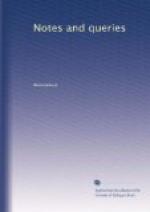BRAYBROOKE.
Audley End.
Bonny Dundee (Vol. ii., p. 134.) is the name attached to one of the most beautiful of the Scotch melodies. The song is said to be very old. The words, which I recollect to have heard sung to it more than half a century ago, began:
“’O, whar gat ye that hauers-meal
bannock,
My bonny young lassie,
now tell it to me?’
’I got it frae a sodger laddie,
Between Saint Johnstone
and bonnie Dundee.”
It is clear that it is to the town, not the man (though from the portraits of him he was very handsome), that the epithet applies. My version of the song differs from that given in Cromek’s Burns, and also from Allan Cuningham’s; and I am disposed to think my memory at fault from the so near recurrence of the word “bonnie” in the stanza.
Neither the date of the birth of Viscount Dundee, nor his age at the time of his death, is mentioned by the Scottish Peerage writers, Crawford, Douglas, or Wood.
F.R.S.L. and E.
Was Quarles pensioned? (Vol. i., p. 201.).—I believe that no reply has been made to this Query. The following passage, transcribed from the “Epistle Dedicatory” to the surreptitious edition of Quarles’s Judgment and Mercy, affords a slight negative proof to the contrary:
“And being so usefull, I dare not doubt your patronage of this child, which survives a father whose utmost abilities were (till death darkened that great light in his soule) sacrificed to your service.”
Now if Charles had conferred a pension on Quarles, is it not exceedingly probable that the publisher and dedicator, Richard Royston, would have recalled so honourable a circumstance to the memory of his “most gratious sovereign King Charles” in this “Epistle Dedicatory,” when he had so excellent an opportunity of doing so?
T.M.B.
Collar of Esses (Vol. ii., p. 140.).—MR. J.G. NICHOLS, in his reply to the Query of [Greek: phi]., says, that “the judges” are among those who are now privileged to wear these collars. Allow me to suggest to him that the privilege among them is limited to the chiefs of the three courts. The other judges certainly now never wear them, and I am unaware that they ever did so. I have a large, though by no means a perfect collection of legal portraits, and there is not one puisne judge or baron so distinguished. The earliest legal worthy who is represented with this collar is in the reign of Henry VIII., and it adorns not a chief justice, but a chancellor, viz. Sir Thomas More; and he is the only chancellor upon whose shoulders it appears. This collar is formed by continuous Esses, without any ornament between them. It is united in the front by two portcullises, with a rose pendant. The print is from Holbein’s picture, and presents him as chancellor, with the purse. The first chief justice wearing the collar is Sir




